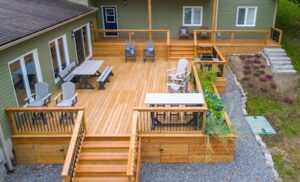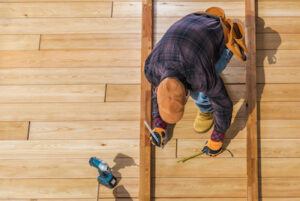Veranda Decking vs Traditional Wood Decking – Which Is Better?
Decking has become a popular way to enhance outdoor living spaces’ aesthetic appeal and functionality. With a wide range of decking materials available, it can be overwhelming to choose the right one for your home. Traditional wood decking has been around for ages, but newer options such as veranda decking have entered the market. So, when comparing veranda decking vs traditional wood decking, which is better?
It depends, as when it comes to durability and maintenance, veranda decking is better. However, traditional wood decking costs less than veranda decking and it has a classic and natural look that is difficult to replicate.
So, now that you have an idea of some differences, let’s dive in and discuss both veranda decking and traditional wood decking. So, keep reading as well will provide an overview of both materials, their advantages, and disadvantages, and help you decide which is better for your home decking needs!

Traditional Wood Decking
Traditional wood decking is made from natural wood, typically harvested from trees such as cedar, redwood, or pressure-treated pine.
The boards are cut and treated to resist rot, insects, and decay, and are then installed to create a flat, level surface for outdoor living spaces.
Advantages Of Traditional Wood Decking
- One of the main advantages of traditional wood decking is its natural and classic appearance.
- Wood decking can create a warm and inviting outdoor living space, and can be customized with different stains and finishes to match your personal style.
- Wood decking is also a relatively affordable option for outdoor living spaces, especially compared to composite materials.
Disadvantages Of Traditional Wood Decking
- One of the main disadvantages of traditional wood decking is its high maintenance requirements.
- Wood decking requires regular cleaning, staining, and sealing to prevent wood rot and decay, and insect infestations.
- Wood decking is also less durable than some composite materials, and can be prone to warping, cracking, and splintering over time.
- The harvesting and transportation of wood decking also has a significant environmental impact.
Veranda Decking
Veranda decking is a composite decking material made from a blend of recycled wood fibers and plastic. The boards are designed to be resistant to rot, insects, and decay, and require less maintenance than traditional wood decking.
Advantages Of Veranda Decking
- One of the main advantages of veranda decking is its durability and low maintenance requirements.
- Veranda decking is resistant to rot, insects, and decay, and does not require regular staining or sealing.
- It is also more resistant to fading, scratching, and staining than traditional wood decking.
- Veranda decking is made from recycled materials, making it an eco-friendly option for outdoor living spaces.
Disadvantages Of Veranda Decking
- One of the main disadvantages of veranda decking is its cost. Veranda decking can be more expensive than traditional wood decking, especially in the short term.
- The boards can also be prone to sagging or warping if not installed correctly and can be more slippery than traditional wood decking when wet.
- Veranda decking may also have a less natural appearance compared to traditional wood decking.

Comparison of Traditional Wood Decking and Veranda Decking
When it comes to choosing between traditional wood decking and veranda decking, there are several factors to consider.
1. Durability
When it comes to durability, veranda decking is more durable than traditional wood decking.
Veranda decking is made from a composite material of recycled wood fibers and plastic, which makes it resistant to weather and insect damage.
Unlike wood decking, it does not rot, warp, or crack easily. Veranda decking is also less prone to splintering, which makes it a safer option for families with children and pets.
On the other hand, traditional wood decking requires regular maintenance, such as staining and sealing, to prevent rotting and insect infestation.
Wood decking is also susceptible to warping, cracking, and splitting, especially when exposed to extreme weather conditions.
2. Maintenance
When it comes to maintenance, veranda decking requires minimal maintenance compared to traditional wood decking.
Veranda decking does not require staining, sealing, or painting, and it can be cleaned easily with soap and water. It is also resistant to fading, staining, and mold growth.
Traditional wood decking, on the other hand, requires regular maintenance to prevent rotting, insect infestation, and weather damage.
Wood decking needs to be cleaned, sanded, stained, and sealed every few years to maintain its appearance and structural integrity.
3. Cost
Veranda decking is generally more expensive than traditional wood decking, but it may be worth the investment in the long run due to its durability and low-maintenance features.
The cost of veranda decking varies depending on the size of the project, the type of veranda decking, and the cost of installation.
On the other hand, traditional wood decking is more affordable than veranda decking, but it requires regular maintenance and replacement due to weather damage and insect infestation.
4. Appearance
Traditional wood decking has a classic and natural look that is difficult to replicate with other materials.
Wood decking comes in a variety of colors and textures, and it can be customized to fit the style and design of the outdoor space.
Wood decking also ages gracefully, and it develops a patina over time that adds to its character and charm.
Veranda decking, on the other hand, has a more modern and uniform appearance. It is available in a variety of colors and patterns, but it does not have the same natural look and feel as traditional wood decking.
Veranda decking also has a consistent appearance, which may not be suitable for those looking for a unique and personalized outdoor space.
Installation Process – Veranda Decking vs Traditional Wood Decking
A. Traditional Wood Decking
The installation process for traditional wood decking involves several steps.
- First, the ground needs to be prepared and leveled.
- Then, the wooden posts are placed in the ground to support the structure.
- The frame is then built using pressure-treated lumber.
- The decking boards are then installed on top of the frame using nails or screws.
- Finally, the wood is sanded and stained to protect it from weather damage.
B. Veranda Decking
The installation process for veranda decking is similar to that of traditional wood decking.
- The ground is prepared and leveled, and a frame is built to support the structure.
- However, veranda decking boards are installed using hidden fasteners or clips, which eliminates the need for nails or screws.
- This creates a more seamless and clean appearance.
Veranda decking also does not require sanding or staining, which reduces the installation time and labor required.
What’s The Right Decking Choice For You?
Choosing between traditional wood decking and veranda decking depends on your specific needs and preferences.
- Traditional wood decking has a classic and natural look, but it requires regular maintenance and is less durable.
- Veranda decking is more durable and low-maintenance, but it may not have the same natural appearance as traditional wood decking.
Ultimately, the decision comes down to factors such as cost, durability, and environmental impact.
In Closing
We have now explored the pros and cons of Veranda Decking versus traditional wood decking. Ultimately, when deciding which option to go with for your home decking needs, we recommend considering two main factors: aesthetics and longevity. If building an outdoor living space you want to be proud of is a priority, then perhaps Veranda Decking offers the best solution in terms of beauty and durability. On the other hand, if budget consciousness is more important than aesthetics or longevity, then consider opting for traditional wood decking instead. By weighing your options carefully, you can find the perfect balance between quality and cost while creating a durable and attractive outdoor area that meets all your needs. With either option you will be creating a backyard space to enjoy for many years to come! Thanks for reading!
FAQs
What Type Of Decking Is Best?
The best type of decking depends on your personal preferences and specific needs for your outdoor space.
Consider factors such as durability, maintenance, cost, appearance, and environmental impact when choosing between different types of decking materials.
How Good Is Veranda’s Decking?
Veranda decking is a high-quality composite decking material made from recycled materials. It is known for its durability, resistance to rot and insects, and low maintenance requirements.
Veranda decking also comes with a 25-year limited warranty, making it a reliable and long-lasting option for outdoor spaces.
How Long Does Veranda Decking Last?
Veranda decking is designed to be a long-lasting and durable material, with a lifespan of up to 25 years or more with proper maintenance.
The exact lifespan of Veranda decking will depend on factors such as the amount of foot traffic, exposure to weather, and maintenance practices.
Does Veranda Decking Get Hot?
Like all decking materials, veranda decking can get hot in direct sunlight, particularly in warmer climates.
However, veranda decking has a lower heat retention rate compared to traditional wood decking, which can become hot to the touch. Also, veranda decking is designed to resist fading, staining, and scratching, even in high-temperature conditions.
